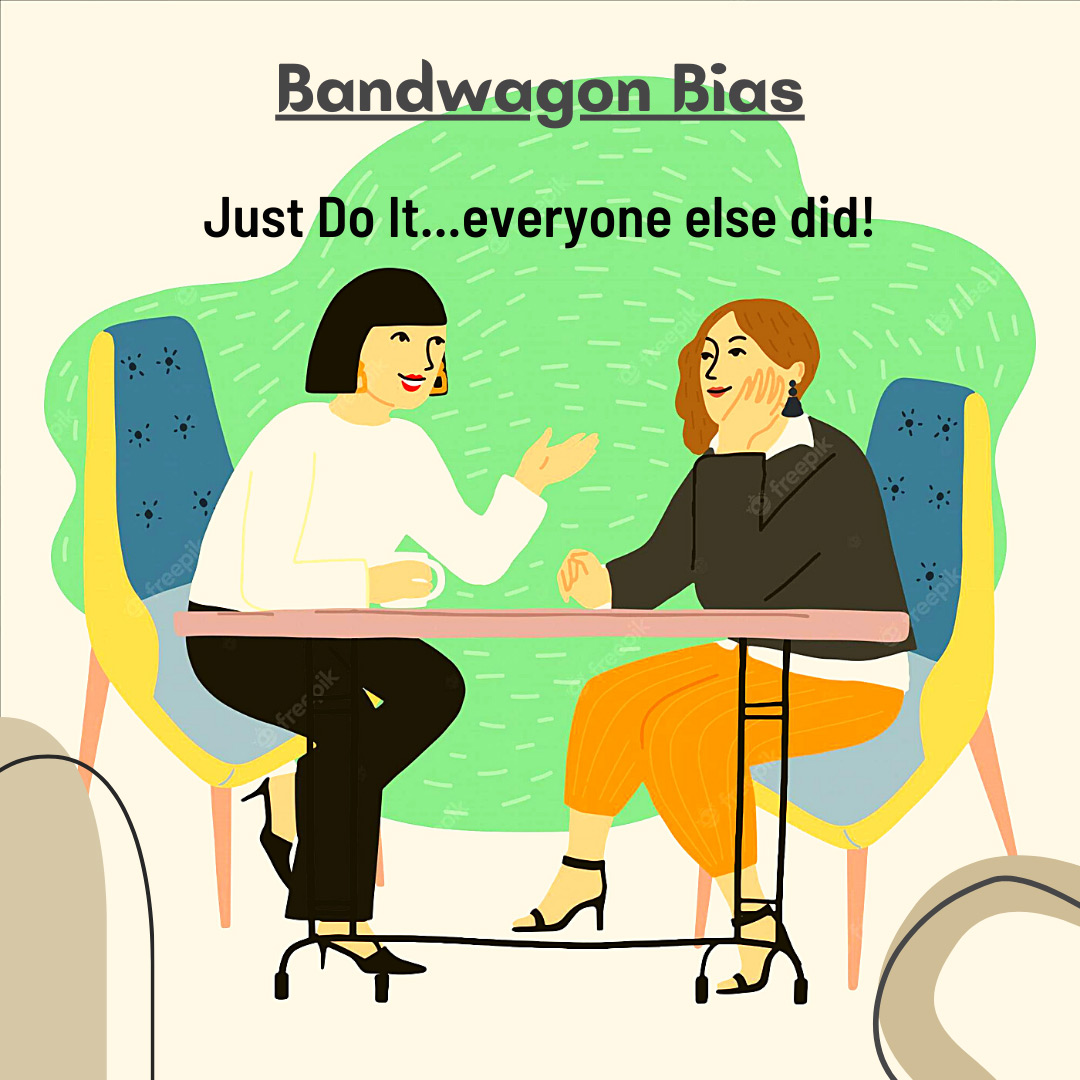Aarav is an avid fan of IPL (Indian Premier League), and his favorite team is the Royal Challengers. Aarav chose Royal Challengers because it has always done well. However, this time his favorite team doesn’t seem to be in its full form. However, his friends in the stadium were cheering for the Knight Riders team, which is leading this time with a good score. It seemed like Knight Riders were the great white shark in the ocean filled with tiny fishes.
People in the stadium who were die-hard fans of the Royal Challengers started switching allegiances to the more dominant and popular team. Seeing the change in the pattern around him, Aarav too decided to join hands with the crowd and started cheering for the Knight Riders. He was indistinguishable from the mass of other fans that formed Knight Riders’ mania.
The snowballing popularity of the Knight Riders and Aarav’s subsequent decision to support them is a product of the bandwagon effect or the bandwagon bias. Yes, the Knight Riders were a good team, however, he began supporting them due to the people around him starting switching allegiances.
The tendency of people to embrace a particular habit, style, or attitude only because everyone else is doing it is known as the “bandwagon effect.” It is more likely that additional individuals will follow suit if a trend gains traction as more people follow it.
The bandwagon effect can go beyond the bandwidth of sports. It has the potential to influence all of the choices we make in life. The main concern is that it might replace the individual critical thinking that frequently underlies wise conclusions. We do not always gain from decisions that many other individuals do.
Consider attending college: while this is a smart move for many people (as shown by the high enrollment in many developed nations), it is not the best option for everyone. Some people could gain greater advantages by choosing to enroll in apprenticeship or trade programs. It is crucial that we assess concepts and actions in light of their value and potential implications for us before making judgments. However, the bandwagon bias persuades us to believe that the popular choice is the best option.
Why Does It Happen?

What causes the bandwagon effect, then? The pressure and norms that groups put on individuals have a significant impact on them. It gets more challenging to refrain from doing something when it appears like the bulk of the group is doing it. We are more likely to adopt an idea or belief that is popular and trendy.
The following are a few factors that can affect the bandwagon effect:
- It takes time to consider a habit or idea and determine whether it is worthwhile to support or not. Many of us see mass acceptance as a signal that we ought to take the same approach. It means that instead of going through the drawn-out process of self-evaluation, we rely on others, as determined by their level of general acceptance.
- The bandwagon effect is also influenced by the fear of exclusion. Going along with what the rest of the group is doing is a technique to assure inclusion and social acceptance because most people do not want to be the odd one out.
- There is a lot of pressure to fit in when it looks like everyone is doing something, which may be why bandwagon behaviors are so easy to establish.
- People strive to be correct. They desire to be on the winning team. People seek other members of their social group for guidance about what is good or acceptable, which contributes to their tendency to comply.
Although the bandwagon effect has great strength and facilitates the rapid creation of trends, these behaviors also have a tendency to be unstable. People swiftly jump on bandwagons, but they also leave them just as quickly. This may be the reason trends are so transient.
Bandwagon Bias And Design Thinking

It is a cognitive bias in which people “strictly adhere” to the opinions of the group as a whole. These can occasionally include forming new routines and beliefs. When the group is trying to come up with as many ideas as it can to address a pain point during brainstorming, this could be very relevant from a Design Thinking perspective.
Let’s take an example where a group is brainstorming ways to guarantee that pupils stay in school when the school is under lockdown. One person proposes using a new app since she notices that most others are using it to achieve the stated goal. Without questioning any of the presumptions, the other members of the group concur with the concept.
1. How Does A Master Practitioner Manage Bandwagon Bias?

Since the bandwagon effect is a cognitive bias, you can lessen its influence on you and others by employing suitable debiasing approaches, which encourage logical thinking and behavior. Such methods consist of the following:
2. Slow down your thought process
Instead of depending on intuition or hasty thinking, it is taking the time to think about the situation slowly and analytically.
Establish ideal possibilities for judgment and choice-making
For instance, choose a quiet place where you can think clearly and concentrate before making a decision that can be impacted by the bandwagon effect.
3. Take one arm’s distance from bandwagon cues
By stepping away from people who put others under pressure, for instance, before making a decision, you can establish physical distance from such indications. Likewise, you can build temporal distance by delaying making a choice for a day after speaking with someone.
4. Stay accountable for your choices
Remind yourself that you are ultimately in charge of whatever decisions you make, regardless of whether they were influenced by the bandwagon effect or another sort of social influence.
5. Think through clearly
For instance, if you’re considering whether to take a specific course of action that’s connected to bandwagon cues, you can openly outline its benefits and drawbacks before verbally outlining your choice and your reasoning.
Not all bandwagon biases are incorrect. When it is inaccurate, it restricts our ability to function efficiently. In order to make better decisions and produce better work, it is important to challenge our biases and consider them in their context. Remember that design thinkers can use social proof to thrive on the bandwagon bias in order to enhance the user experience and customer journey of their products.
https://www.interaction-design.org/literature/article/the-bandwagon-bias-the-dangers-of-groupthink
https://thedecisionlab.com/biases/bandwagon-effect
https://effectiviology.com/bandwagon/
https://www.wallstreetmojo.com/bandwagon-effect/
https://www.membrain.com/hubfs/lemmings-bandwago-effect-in-b2b-salesd.jpg
https://www-cms.pipedriveassets.com/blog-assets/cognitive-bias-sales_200512_180202.png
https://www.meta-media.fr/wp-content/uploads/sites/33/2018/04/Couverture-Design-Thinking-02.png
Written By: Jimmy Jain
Edited By: Afreen Fatima
Society of Design Thinking Professionals









